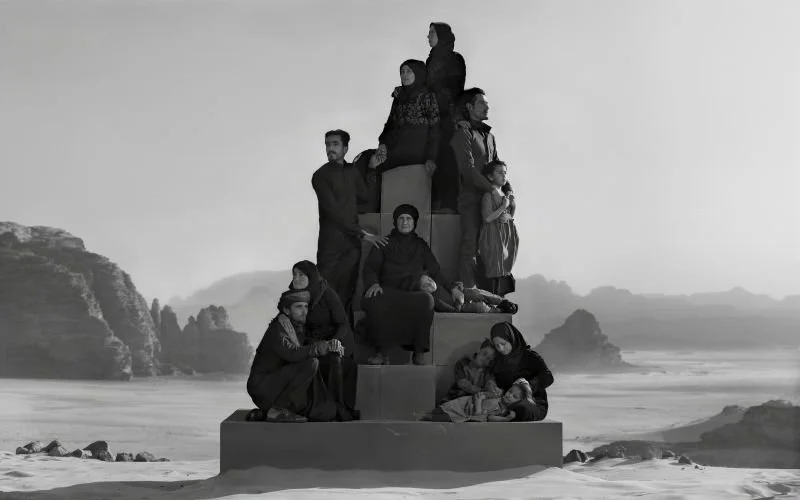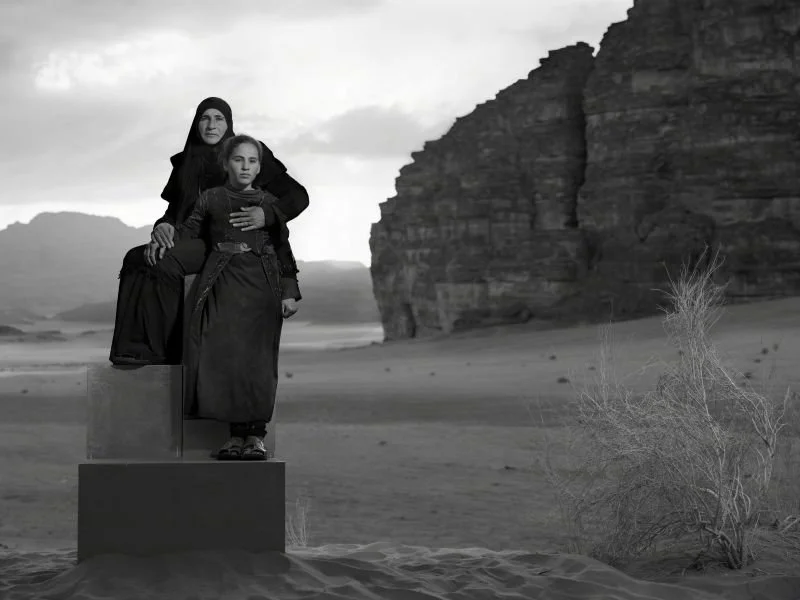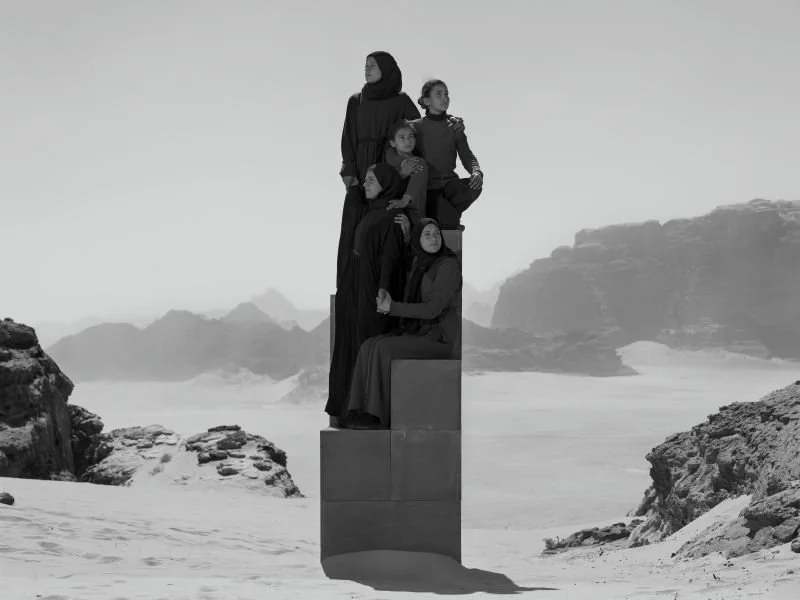NICK BRANDT's images of strength & resilience in the face of climate change
Ftaim and Family, Jordan, 2024
Photographer Nick Brandt presents The Day May Break, an ongoing project exploring the human and environmental toll of climate change around the world, in multiple new exhibitions around Europe and a new book release this autumn on the heels of major exhibitions earlier this year.
The Day May Break is a global series featuring humans and animals impacted by climate change and environmental degradation, depicting the strength and resilience of those who are facing such challenges. It currently consists of four chapters, each depicting a different part of the world.
Hangar Art Center in Brussels, Belgium, is currently showing a two-floor exhibition of The Day May Break, Chapters One-Three, with a preview of the fourth chapter, The Echo of Our Voices. The exhibition is on display until December 21, 2025.
This coincides with the book release of The Echo of Our Voices (published by Skira Editore), presenting photographs of this powerful series with a foreword by Syrian novelist Samar Yazbek and an introduction by curator Arianna Rinaldo.
Interview by Isabel Hou
The title The Echo of Our Voices suggests reverberation, memory, and persistence. What echoes did you want to capture here, and whose voices are resonating most strongly for you in this work?
It’s the voices of the Syrian families in the photographs. That through all the combined trauma of perpetual displacement—first from war, and now from climate change—their voices remain strong, resonant, resilient.
The Cave, Jordan, 2024
The Echo of Our Voices highlights rural Syrian families who fled the war and are now living in Jordan, one of the most water-scarce countries in the world. What drew you to this community, and how do environmental issues shape their daily lives?
In the weeks before I arrived in Jordan, my wonderful researcher, Lubna, was traveling around Jordan meeting people impacted by climate change. Because she had spent years working with Syrian refugees, she included many among the Jordan people also impacted by climate change.
When I arrived, we spent a couple of weeks traveling around the country meeting some of the people she interviewed. There was something about the Syrian families that drew me to them the most. Having fled the war in Syria in the years 2013-15, they were now living lives of continuous displacement due to climate change, forced to move up to several times a year, moving their tents to wherever there has been sufficient rainfall for crops to grow and for them to find work in the fields.
It’s a cycle with no end in sight while they live in Jordan. They themselves all see how dramatic the changes have been over the last decade, their lives so compromised by the dramatically diminished winter rains.
As they said, water is life. And life is getting harder. So, I wasn’t expecting the project to be all Syrian families, but for me, their lives give an additional dimension to the photographs.
Fasel and Inas, Jordan, 2024
Looking across the series, from South Pacific Islanders to Bolivia and Sende Verde Wildlife Sanctuary, and earlier chapters in Zimbabwe and Kenya, how do you decide which locations and groups to photograph? What themes unify them across continents?
For the first two chapters, in Kenya, Zimbabwe and Bolivia, the locations were dictated by animal sanctuaries and conservancies where the rescued, formerly wild animals were habituated to humans. This made it possible for us to photograph the animals and people together in the same frame.
For the people, researchers again scoured each country in search of people who had experienced significant trauma as a result of climate change such as years-long extreme droughts or floods or cyclones intensified by climate change. In Kenya, in particular, many were climate refugees, forced to leave their homes, their land, their livelihood and start all over again somewhere new.
Spread across the planet, there is a common link between the countries in which I have photographed this series so far: they all are among the countries that are the least responsible for climate breakdown. Their global carbon emissions have been tiny compared to those of industrial nations. Yet, like so many other poorer countries in the world, they are disproportionately harmed by its effects. The grim irony is that many people in these countries are the most vulnerable to the calamitous consequences of the industrialized world’s ways.
Nick Brandt
The book includes a foreword by Syrian novelist Samar Yazbek and an introduction by curator Arianna Rinaldo. How did these collaborations come about, and in what ways do their perspectives deepen or reframe how the project is understood?
In the case of Samar, for me it’s imperative to have the voice of a Syrian speak of the families’ experiences of their exile. I may have spent two months with the families, but of course, as an outsider, there is only so much I can understand about the details. My focus is injustice, unfortunately a universal condition wherever you are.
As a curator, Arianna has been a wonderful supporter of my work over the years, and introduced me to Gallerie d’Italia museum in Turin. I pitched the concept of The Echo of Our Voices to them. I am deeply grateful that they offered to partially fund this chapter and in March 2026, exhibit all of The Day May Break, with emphasis on this chapter.
Majed and Mariam in Moonlight, Jordan, 2024
In Jordan, you photographed families who had already endured displacement from war and were now facing ecological precarity. How did you approach building trust in such a sensitive environment, and what stories from those conversations stayed with you?
After meeting the families in their homes (tents) around Jordan, we invited about seven families at a time for six-day weeks. That gave us and them time to get to know each other as each day we photographed them. They would come over to the camera at the end of each session and look at what I photographed. This helped them understand what we were trying to achieve, so that by the third or fourth day, they had a pretty clear idea.
Initially, we were very much choreographing their poses, but towards the end of each week, they were also suggesting connections between each other on the boxes. So, it became increasingly collaborative, which is how I like to work.
The stories that stayed with me the most are a) the lives that they were forced to abandon in Syria, and b) the dreams of the some of the whip-smart young girls, who, with the complexity of being refugees and the economic necessity of also working in the fields, will be made so much harder to fulfill.
Laila Standing, Jordan, 2024
A striking motif in The Echo of Our Voices is the stacked boxes that families gather together, reaching skyward. Can you walk us through how you conceptualized and executed this motif, and what it symbolizes?
The concept developed into this: human islands/sculptures of family members whose lives are dramatically impacted by climate change, gathered together in a vast arid desiccated expanse.
The stacks of boxes upon which the families sit and stand aim skyward—a verticality implying a strength or defiance—and provide pedestals for those that in our society are typically unseen and unheard. Not generals or politicians of history, but human beings that I consider more worthy of elevation in the world.
These are people who lost their homes, their way of life, their communities, their land, everything. Now all they have is each other. It seems to have given them a strength and togetherness in the face of such adversity. There was, is, a grace and humility to them, that perhaps also made them connect more with the principle of the project.
Kamal Family, Jordan, 2024
You’ve often worked with natural light and expansive landscapes. How did the Jordanian setting, both visually and logistically, challenge or expand your photographic practice?
I have always tried to photograph in the rainy season to maximize my chance of photographing in the soft, somber—and for me melancholy—light of overcast skies. But this of course is climate change, so during 36 days of photographing, I think I had one genuinely overcast day. But then I realized, this is about climate change and so whether I like it or not aesthetically, I need to embrace the harsh sunlight, which is what I then did.
We always photographed into the sun or back three quarters lit, so that the mountains were mainly silhouetted, emphasizing the visual flow of mountains into people. So, I also used a powerful light that helped fill in the shadows on the people.
Women with Sleeping Children, Jordan, 2024
You’ve spoken before about climate change as not just an environmental crisis but a humanitarian one. With The Echo of Our Voices, what conversation do you hope to spark that goes beyond the visual experience of the work?
Yes, it’s both an environmental and humanitarian crisis. Those of us viewing these photos probably live comfortable lives in comparison to those in the photographs. We have some kind of social safety net in the event of dramatic loss or disaster in a way the people I photograph do not. So, I would hope that this work helps foster more awareness, both emotionally and intellectually, of those in the world often significantly impacted by the actions of those in a less fortunate place.
Connected to that, I would like people to consider this: Are you being a good ancestor? Are you considering the environmental impact that your actions will have on future generations, on those billions of humans, animals and trees that you will never live to see.
Rakan Sisters, Jordan, 2024
The project has been exhibited internationally. What responses have you heard—from policymakers, activists, or even the families themselves—that suggest how art like this might influence action?
The response from the people in the photos has always been very moving. We interview many of them at the end of each shoot, and invariably hear the same thing: “Thank you for hearing us. Thank you for seeing us.”
Activists have also always had very positive reactions. As for policymakers, I haven’t been able to reach those people in any meaningful way, and that is disappointing, frustrating, but not surprising. I’m just a photographer, so I don’t know that I should expect much.
Zaina, Laila and Haroub, Jordan, 2024
Do you imagine The Day May Break as a finite project, or does each chapter open the door to further echoes? Where do you feel the series is leading you next?
I never really know where I am heading next. I mean, I think I do, and then something happens, like, as you say, one chapter opening the door to further echoes.
I am sure that the work will always relate to injustices of some kind, and the duality of the title The Day May Break means this series could continue indefinitely as it encompasses both darkness and light.
Did you like what you read here? Please support our aim of providing diverse, independent, and in-depth coverage of arts, culture, and activism.
Isabel Hou is a graduate student at Columbia University's School of International and Public Affairs and a Cornell alumna with an interest in policy, governance, and emerging technologies. A lifelong artist, she is passionate about storytelling and highlighting creative voices. In her free time, she enjoys skiing, cooking, and New York’s arts and culture scene.
All photographs © Nick Brandt, courtesy of the artist














